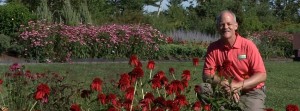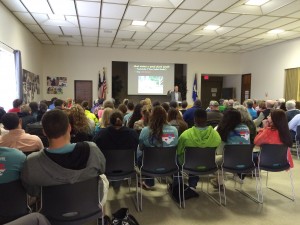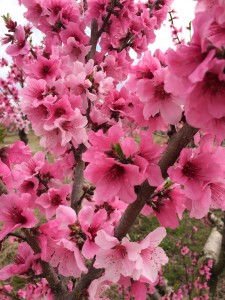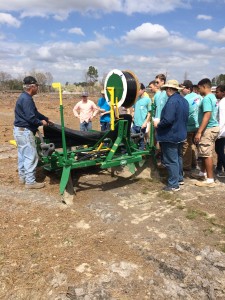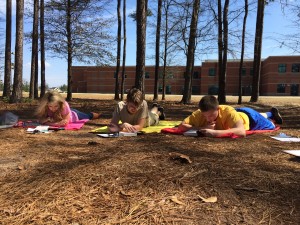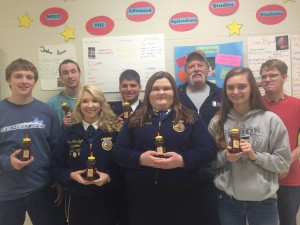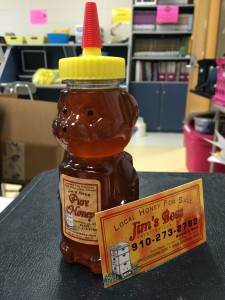Lesson Two of my KFP curriculum consists of various activities to explore the pros and cons of local foods and conventional foods based on economics, the environment, and quality.
To explore the economic characteristics of local foods, we took a field trip, of course! One of my lovely mentors, Mack Johnson (Horticulture Extension Agent), invited my class to a seminarat the Robeson County Extension Office on modern horticulture by THE Bryce Lane. In case you don’t know who Bryce Lane is, just check out one of his Emmy winning “In the Garden” episodes at http://video.unctv.org/program/garden/.
Just plain awesomesauce!
Back to the field trip: I decided to use this chance to make a day-long field trip for any interested agriculture education student. We began at 8:30am and visited a Gray’s Creek farm, S&K Growers owned by Mr. Ryan Kennedy, and ended the day with a visit to Geraldine’s Peaches and Produce Farm in Lumberton, NC, owned by the Herring family (in the middle was THE Bryce Lane.)
My 33 students, along with some green thumbers listening to THE Bryce Lane. 🙂
Ryan Kennedy is a graduate of Gray’s Creek High School and a row crop farmer. Within the two years, he has formed S&K Growers and began selling seasonal ornamental plants and vegetables. He has four contracts with local restaurants to supply their winter produce (tomatoes, bell peppers, cucumbers, and lettuce.) He utilizes two greenhouse to sell his plants and he heats them with corn from the row crop farmer.
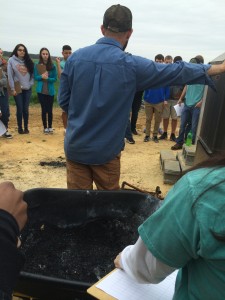 Mr. Kennedy showing the students his boiler system for greenhouse heat. (I swear that I had more pictures…but my phone ate them!)
Mr. Kennedy showing the students his boiler system for greenhouse heat. (I swear that I had more pictures…but my phone ate them!)
The great thing about S&K Growers is that anyone can come and pick their own produce on the weekends! How lovely! The average price for a tomato is $4 a pound. The students were not shocked by this price yet…..
Our afternoon visit was led by Geraldine and Brooke Herring, a strong mother-daughter team that are great at marketing their farm and giving tours! The Herring Farm is a field vegetable farm and peach orchard. The students were able to analyze the difference in growth practices and produce prices between this farm and S&K Growers from earlier in the day. The Herrings grow and sell every summer vegetable imaginable, muscadine grapes, nectarines, and peaches. They have their own permanent roadside stand and will begin operating their own CSA program this summer. They also sell fall and winter vegetables using a “pick and pay honor system.”
We toured the peach orchard and discussed pruning techniques and cultural practices.
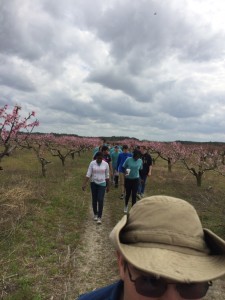
The peach orchard with over 3,000 peach trees!
BEAUTIFUL blossoms! Feel free to download this and use it as a wallpaper on this beautiful spring day- you’re welcome!
Mr. Roy, the man behind the scenes, paid a visit to show the students the black plastic application equipment that they use for most row vegetables.
Geraldine and Brooke led a discussion about their spring and summer vegetables. They discussed the labor, timeline, and marketing involved in selling their produce. They told the students about their passion for farming, but that they know they will never be rich. The Herring Farm is in Robeson County, the third poorest county in the nation. They are not able to charge a high amount for their produce and still remain competitive. For example, they charge $1.00 per pound of tomatoes (Remember, Mr. Kennedy sells his $4.00 per pound in the Fayetteville market). Students were able to see the difference that market and informed customers can make in the slim profit margin in farming.
After our vegetable discussion, I saw an older Winter Collard patch and asked Mrs. Geraldine if the student’s could “taste test” fresh collards from the field. She said, “Sure! We are about to till those into the ground anyway- go ahead and cut them down and take them home with you!” The students shot weird glances to one another as if they were thinking, “Just take a whole collard plant, right now?!” One student wasn’t controlled by what his peers thought and jumped right in. Soon, the other students began to realize the “cool factor” of free plants and jumped right in!
Look at how happy they are!
Before we knew it, nearly every student had cut down a free head of collards to take home to their families.
Check out the “Cool Collard” Group! Yes, I’m grinning with that group!
We thanked the Herrings for their generosity and kindness and returned back to Gray’s Creek. Upon our return, we compared the prices for tomatoes and cucumbers of the two “local farmers” with two local supermarkets. Students found that Mr. Kennedy had the high prices, while the Herrings had the lowest prices around; however, customers have to wait until the peak of summer to reach that low price.
I am thankful for generous extension agents and farmers, my fabulous school system, and students that are eager to learn about agriculture and what it means for our society.

